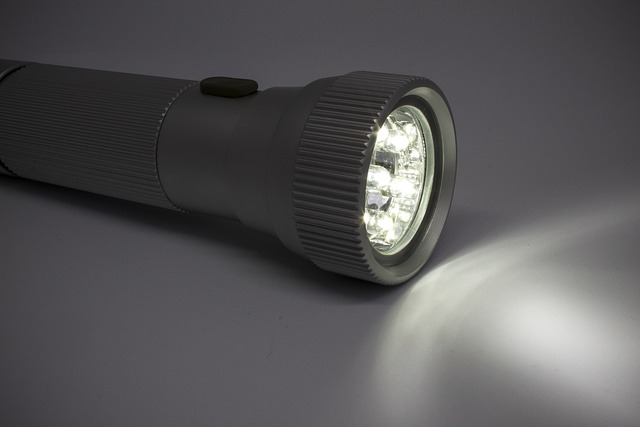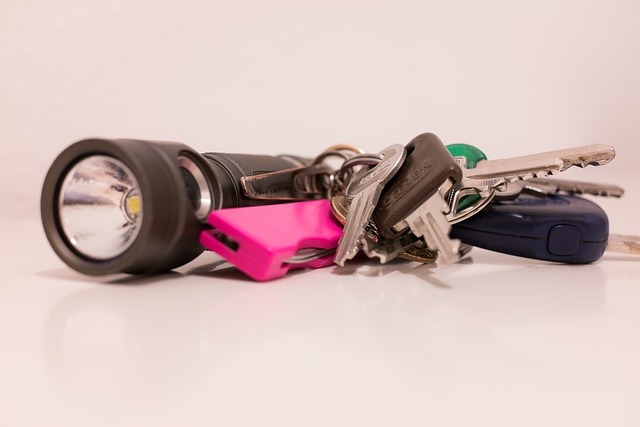Flashlights for home use with rechargeable batteries are a sustainable and cost-effective addition to any household emergency kit and daily utility application. These devices offer environmental benefits by reducing the reliance on disposable batteries and provide economic savings over time. Rechargeable flashlights, powered by eco-friendly technologies like lithium-ion or nickel-metal hydride (NiMH) batteries, are designed for frequent use without the need for constant battery replacements. NiMH batteries are reliable for everyday tasks and emergencies, offering consistent performance and cost-effectiveness, while Li-ion batteries provide greater energy density, longevity, and efficiency, making them ideal for those seeking top-tier performance and minimal charging frequency. High-quality flashlights feature durable construction with materials like aircraft-grade aluminum, waterproofing, intuitive interfaces with precise battery level indicators, high-output LEDs with adjustable light modes, and safety features like a strobe function. They are versatile tools for home use, suitable for various tasks and emergencies, and their long-term use reduces the environmental impact of single-use batteries. Proper maintenance, including regular monitoring, storage in a cool, dry place, adherence to manufacturer guidelines on charge cycles, and cleaning with a soft cloth, ensures that these flashlights remain reliable illumination sources for years to come.
Exploring the shift towards energy-efficient solutions, this article illuminates the benefits of rechargeable flashlights for home use. Delving into the technology and comparing NiMH and Li-ion batteries, it guides readers on selecting the most suitable option. We’ll highlight key design features and offer practical advice for maximizing efficiency and lifespan. Whether preparing for emergencies or enhancing daily tasks, rechargeable flashlights are a prudent addition to any household, ensuring readiness while cutting down electricity costs. Join us as we shed light on the bright future of home energy savings with rechargeable flashlights.
- Understanding Rechargeable Flashlight Technology: The Basics and Benefits for Home Use
- Comparison of Rechargeable Battery Types: NiMH vs. Li-ion for Home Applications
- Design and Features to Look for in a High-Quality Home Rechargeable Flashlight
- Energy Savings and Efficiency: How Rechargeable Flashlights Reduce Electricity Costs
- Practical Applications of Rechargeable Flashlights in Home Emergencies and Daily Use
- Maximizing the Lifespan of Your Rechargeable Flashlight: Maintenance and Best Practices
Understanding Rechargeable Flashlight Technology: The Basics and Benefits for Home Use

Rechargeable flashlights have become a staple in household emergency kits and everyday utility due to their energy-efficient design and reliability. These devices harness rechargeable battery technology, which not only reduces the environmental impact associated with disposable batteries but also offers significant cost savings over time. For home use, flashlights for home use with rechargeable batteries are a wise choice as they can be used repeatedly without the need to purchase new batteries. This feature ensures that during power outages or when navigating through dark spaces, homeowners have a dependable light source ready at their disposal.
The basic mechanics of rechargeable flashlights involve a built-in rechargeable battery pack, often lithium-ion or nickel-metal hydride (NiMH), that can be charged hundreds of times. This technology provides consistent luminosity and can be tailored to various light outputs, allowing users to select the brightness level needed for a specific task or situation. The benefits of using flashlights for home use extend beyond energy savings; they offer convenience, as the devices can be recharged using a standard electrical outlet. Additionally, the durability of rechargeable batteries means that over time, users will experience fewer replacements and less maintenance, making these lights not only an eco-friendly option but also a cost-effective one for long-term home use.
Comparison of Rechargeable Battery Types: NiMH vs. Li-ion for Home Applications

When it comes to home applications, flashlights powered by rechargeable batteries offer a sustainable and cost-effective lighting solution. Among the various rechargeable battery types available, NiMH (Nickel-Metal Hydride) and Li-ion (Lithium-ion) stand out due to their distinct characteristics and performance in home settings.
NiMH batteries have been a staple in rechargeable technology for years, offering reliable power with a high capacity for repeated discharges and charge cycles. They are known for their ability to be recharged at a lower cost compared to Li-ion batteries. Flashlights with NiMH cells are an excellent choice for homeowners who require a dependable light source for everyday tasks or emergencies. However, while NiMH batteries perform well generally, they tend to have a higher self-discharge rate and can be less energy-efficient over time compared to Li-ion.
Li-ion batteries, on the other hand, provide a more energy-dense alternative with a longer lifespan and higher energy efficiency. They charge faster, hold their charge for extended periods, and have a lower self-discharge rate than NiMH batteries. For home use, flashlights equipped with Li-ion cells are ideal for situations where frequent charging is inconvenient or for users who demand the best performance from their lighting tools. The initial cost of Li-ion batteries may be higher, but their longevity and consistent output make them a more economical choice over time, especially when used regularly. When selecting between NiMH and Li-ion flashlights for home use, it’s essential to consider the specific needs and usage patterns of the household to determine which battery type offers the most value and convenience.
Design and Features to Look for in a High-Quality Home Rechargeable Flashlight

When selecting a high-quality home rechargeable flashlight, design and features are paramount to ensure both efficiency and reliability during power outages or late-night tasks. For starters, look for flashlights that offer a robust construction with durable materials like aircraft-grade aluminum, which not only adds to the lifespan of the product but also makes it lightweight and resistant to impact and corrosion. A high-quality home rechargeable flashlight should be waterproof or water-resistant, ensuring safety and performance even in harsh environments or during sudden weather changes.
In terms of features, opt for models with a user-friendly interface that includes an easy-to-operate charging system, preferably with LED indicators to display battery levels accurately. A high-output LED is essential for maximum brightness, as it provides a clear and powerful beam that can illuminate large areas or focus on tasks at hand. Additionally, consider flashlights with variable light modes, including low, medium, and high settings, which extend the battery life when less light is needed. Some of the best home rechargeable flashlights also offer a strobe function for signaling or disorienting in emergency situations. Features such as adjustable focus and a sturdy pocket clip can enhance both usability and portability, making your flashlight an indispensable tool for home safety and convenience.
Energy Savings and Efficiency: How Rechargeable Flashlights Reduce Electricity Costs

Rechargeable flashlights have become a practical and eco-friendly choice for homeowners looking to reduce their electricity costs. Unlike their disposable counterparts that require frequent battery replacements, rechargeable flashlights offer a more sustainable solution. By utilizing rechargeable batteries or built-in solar panels, these devices eliminate the need for single-use options, which not only saves money but also minimizes waste. The energy savings stem from the efficiency of rechargeable technologies; they can be used repeatedly without incurring the costs associated with purchasing new batteries. This aspect is particularly advantageous for frequent use, such as during power outages or when navigating through dark spaces, ensuring that homeowners have a reliable light source at their disposal without the constant financial investment. Furthermore, the lifespan of rechargeable flashlights is significantly longer than traditional ones; they provide consistent performance over time, making them not only cost-effective but also a responsible choice for households aiming to decrease their environmental footprint and manage energy expenses effectively. Flashlights for home use that are rechargeable represent a prudent investment, offering both economic and ecological benefits.
Practical Applications of Rechargeable Flashlights in Home Emergencies and Daily Use

Rechargeable flashlights have become indispensable tools for homeowners, offering both energy savings and reliable illumination during power outages or other emergencies. Their ability to provide consistent light over an extended period without the need for frequent battery replacements makes them a practical choice for maintaining safety and functionality in the event of a home emergency. For instance, during a sudden blackout, a rechargeable flashlight ensures that you can navigate through your home safely, check on family members, or perform essential tasks without the anxiety of diminishing battery power. Moreover, these flashlights are designed with durability in mind, often featuring shock-resistant housing and water-resistant seals, which means they can withstand the rigors of daily use, from minor mishaps to more routine chores like inspecting the garage or working on home improvement projects in dimly lit areas. The convenience of charging them via a standard outlet or USB port also eliminates the hassle of scavenging for batteries when they’re most needed.
On a day-to-day basis, flashlights for home use serve as versatile lighting solutions that complement a well-prepared household. They can be used for everyday tasks such as reading in bed, finding your way around during a late-night bathroom trip, or providing ample light when checking on a suspicious noise outside at night. Their rechargeable nature means you always have a fully operational light source ready without the need to store and frequently replace disposable batteries. This not only simplifies home maintenance but also contributes to reducing waste and promoting energy efficiency within the household, aligning with sustainable living practices.
Maximizing the Lifespan of Your Rechargeable Flashlight: Maintenance and Best Practices

To ensure your rechargeable flashlight serves you faithfully for home use over an extended period, adhering to a few maintenance and best practices is paramount. Firstly, regularly check the battery level indicator to avoid over-discharging, which can shorten the battery’s lifespan. Storing your flashlight in a cool, dry place when not in use helps maintain optimal performance and longevity of both the light and its power source. Rechargeable batteries have a finite number of charge cycles; using and charging them as recommended by the manufacturer extends their useful life. Between uses, it’s wise to fully charge the flashlight beforehand to ensure the battery is at peak capacity when you need illumination most.
Additionally, cleaning your flashlight regularly can prevent corrosion and ensure a proper connection between the battery and the light. Use a soft cloth to gently wipe down the exterior, being careful not to get any liquid inside. For the best performance, use the flashlight provided charger or one that matches its specifications; using unsuitable chargers can damage the battery. When replacing batteries, opt for high-quality cells compatible with your flashlight model to maintain consistent brightness and runtime. By following these practices, you’ll maximize the lifespan of your rechargeable flashlight, ensuring it remains a dependable home utility during power outages or late-night tasks.
When considering flashlights for home use, embracing rechargeable technology is a prudent choice for both energy savings and performance. This article has elucidated the fundamental aspects of this technology, its benefits over traditional options, and the nuances between NiMH and Li-ion batteries. It has also highlighted key design features that contribute to a high-quality rechargeable flashlight’s reliability in everyday scenarios and critical emergencies. By adopting these devices, households can significantly cut down on electricity costs while maintaining a consistent and dependable light source. Proper maintenance and best practices ensure the longevity of these investments, making rechargeable flashlights for home use not just a smart environmental choice but also an economical one. In conclusion, for those seeking to reduce their carbon footprint and energy expenses, investing in quality rechargeable flashlights is a step well-taken.
